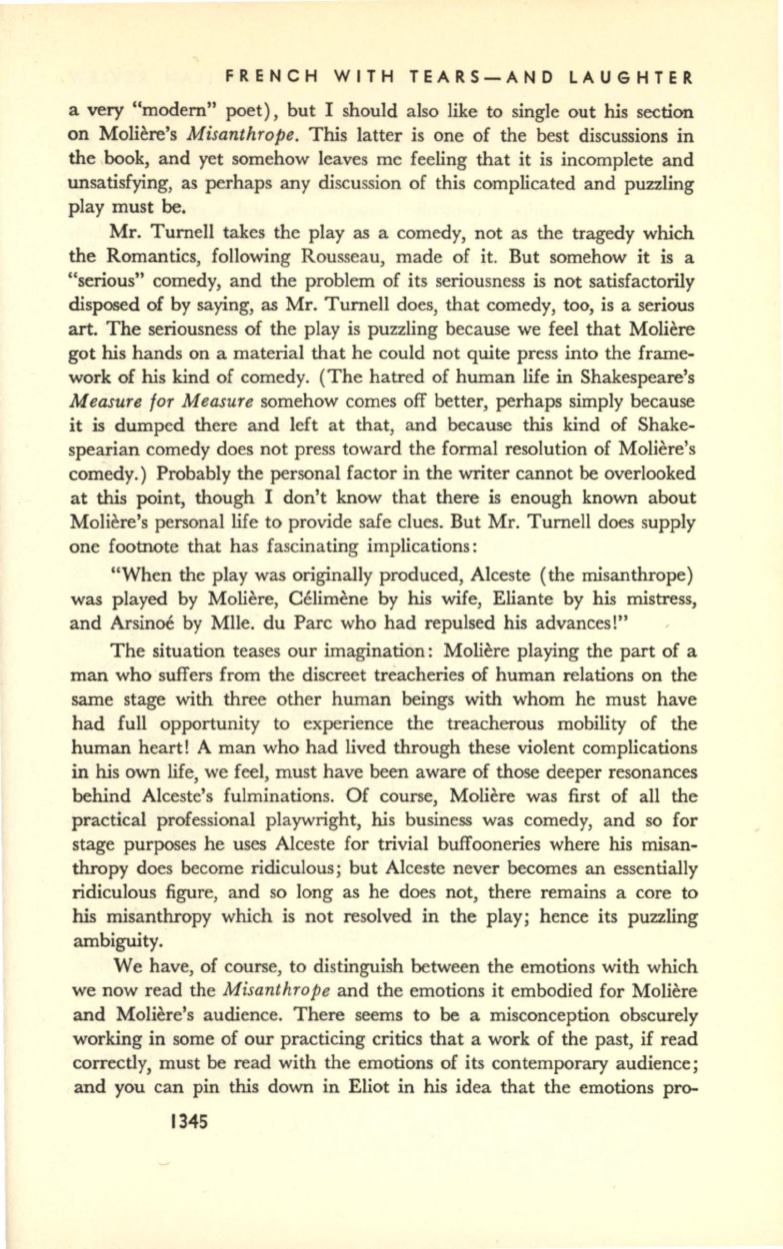
FRENCH WITH TEARS-AND LAUGHTER
a very "modern" poet), but I should also like to single out his section
on Moliere's
Misanthrope.
This latter is one of the best discussions in
the book, and yet somehow leaves me feeling that it is incomplete and
unsatisfying, as perhaps any discussion of this complicated and puzzling
play must be.
Mr. Turnell takes the play as a comedy, not as the tragedy which
the Romantics, following Rousseau, made of it. But somehow it is a
"serious" comedy, and the problem of its seriousness is not satisfactorily
disposed of by saying, as Mr. Turnell does, that comedy, too, is a serious
art.
The seriousness of the play is puzzling because we feel that Moliere
got his hands on a material that he could not quite press into the frame–
work of his kind of comedy. (The hatred of human life
in
Shakespeare's
Measure for Measure
somehow comes off better, perhaps simply because
it is dumped there and left at that, and because this kind of Shake–
spearian comedy does not press toward the formal resolution of Moliere's
comedy.) Probably the personal factor in the writer cannot
be
overlooked
at
this
point, though I don't know that there
is
enough known about
Moliere's personal life to provide safe clues. But Mr. Turnell does supply
one footnote that has fascinating implications:
"When the play was originally produced, Alceste (the misanthrope}
was played by Moliere, Celimene by his wife, Eliante by his mistress,
and Arsinoe by Mlle. du Pare who had repulsed his advances!"
The situation teases our imagination: Moliere playing the part of a
man who suffers from the discreet treacheries of human relations on the
same stage with three other human beings with whom he must have
had full opportunity to experience the treacherous mobility of the
human heart! A man who had lived through these violent complications
in
his own life, we feel, must have been aware of those deeper resonances
behind Alceste's fulminations. Of course, Moliere was first of all the
practical professional playwright, his business was comedy, and so for
stage purposes he uses Alceste for trivial buffooneries where his misan–
thropy does become ridiculous; but Alceste never becomes an essentially
ridiculous figure, and so long as he does not, there remains a core to
his misanthropy which is not resolved in the play; hence its puzzling
ambiguity.
We have, of course, to distinguish between the emotions with which
we now read the
Misanthrope
and the emotions it embodied for Moliere
and Moliere's audience. There seems to be a misconception obscurely
working in some of our practicing critics that a work of the past, if read
correctly, must be read with the emotions of its contemporary audience;
and you can pin this down in Eliot in his idea that the emotions pro-
1345


